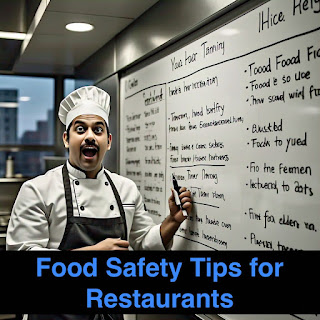Here are some essential food safety tips for restaurants and food establishments:
I. Food Handling and Preparation
1. Handle food safely: Separate raw, cooked, and ready-to-eat foods to prevent cross-contamination.
2. Cook food to safe temperatures: Use a food thermometer to ensure foods are cooked to a safe internal temperature.
3. Chill foods promptly: Refrigerate foods promptly and keep them at a temperature of 40°F (4°C) or below.
4. Prevent cross-contamination: Use separate equipment, utensils, and cutting boards for raw and ready-to-eat foods.
II. Food Storage and Disposal
1. Store foods properly: Store foods in covered containers and label them with the date and contents.
2. Rotate foods: Rotate foods regularly to ensure older items are used before they expire.
3. Dispose of waste properly: Dispose of waste regularly and keep the dumpster area clean and free of pests.
III. Cleaning and Sanitation
1. Clean and sanitize equipment: Clean and sanitize equipment regularly, including utensils, cutting boards, and dishes.
2. Clean and sanitize surfaces: Clean and sanitize surfaces regularly, including countertops, tables, and floors.
3. Use proper cleaning and sanitizing solutions: Use proper cleaning and sanitizing solutions and follow the manufacturer's instructions.
IV. Pest Control
1. Prevent pest infestations: Seal cracks and crevices, and keep the establishment clean and free of food debris.
2. Use pest control measures: Use pest control measures, such as traps or insecticides, as needed.
3. Monitor for pests: Monitor for pests regularly and take action promptly if an infestation is detected.
V. Employee Health and Hygiene
1. Require employee handwashing: Require employees to wash their hands regularly, especially after using the restroom and before handling food.
2. Require employee glove use: Require employees to wear gloves when handling food and to change them regularly.
3. Monitor employee health: Monitor employee health and require employees to report any illnesses or symptoms.
VI. Food Safety Training
1. Provide food safety training: Provide food safety training to all employees, including managers, cooks, and servers.
2. Train employees on food safety procedures: Train employees on food safety procedures, including handling, preparation, and storage of foods.
3. Require employee certification: Require employees to become certified in food safety, such as through a food safety certification program.
VII. Record Keeping and Inspections
1. Keep accurate records: Keep accurate records of food safety procedures, including temperature logs, cleaning schedules, and pest control measures.
2. Conduct regular inspections: Conduct regular inspections of the establishment to ensure compliance with food safety regulations and procedures.
3. Correct deficiencies promptly: Correct deficiencies promptly and take action to prevent future occurrences.
By following these food safety tips, restaurants and food establishments can help ensure the safety of their customers and prevent foodborne illnesses.











0 comments:
Post a Comment